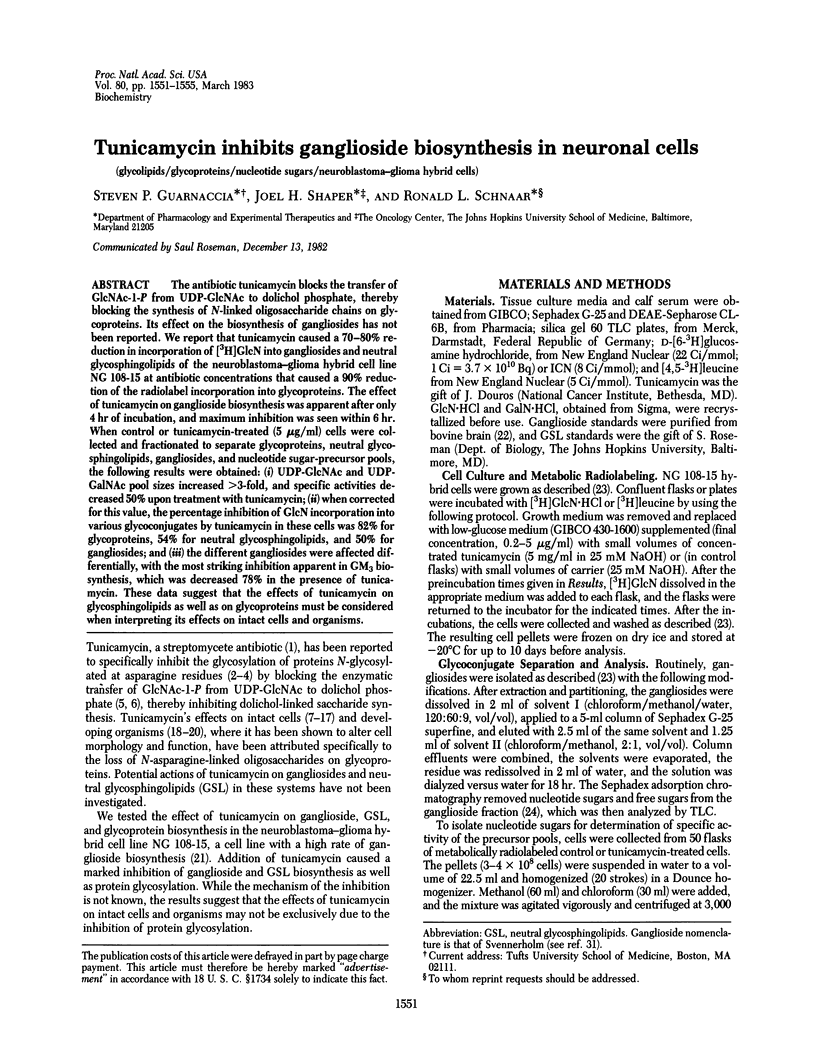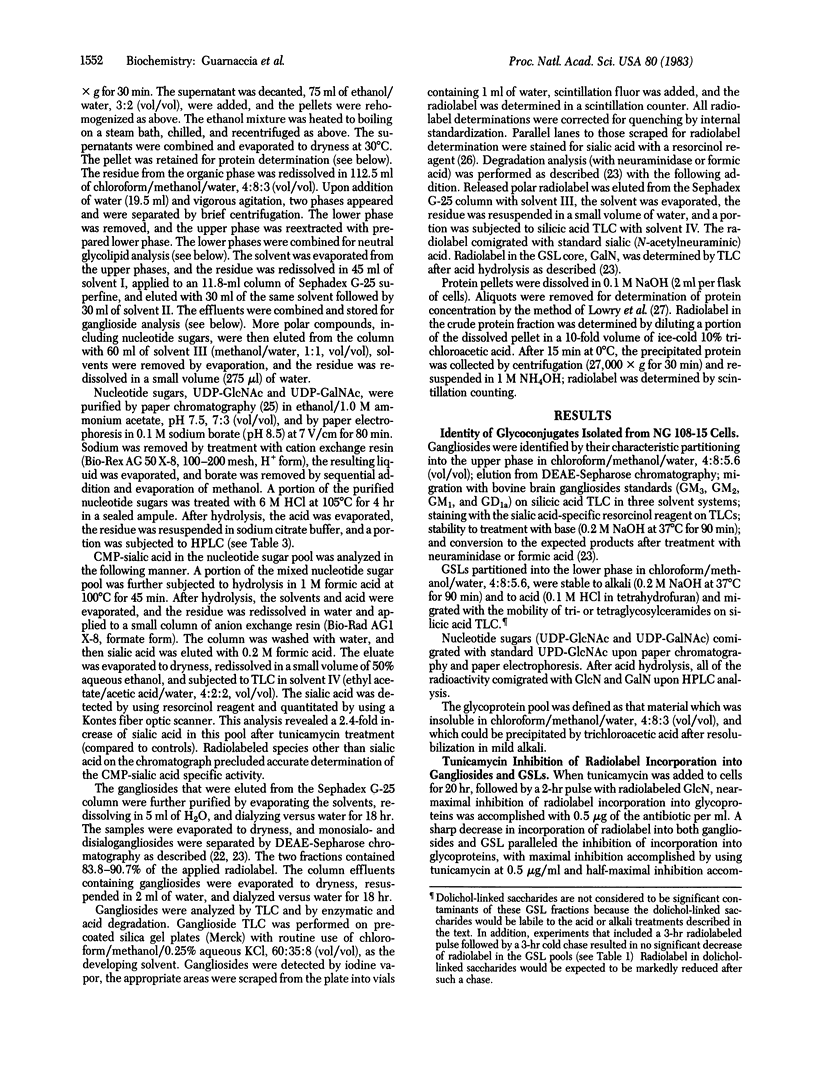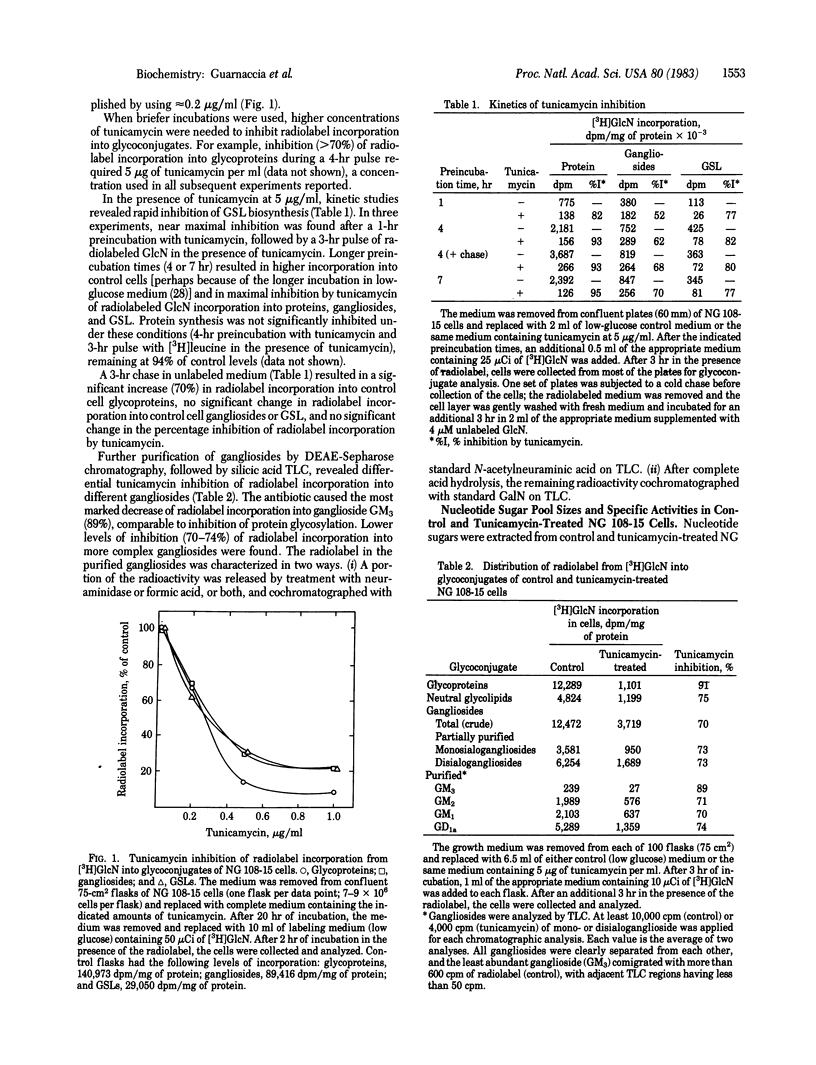Abstract
The antibiotic tunicamycin blocks the transfer of GlcNAc-1-P from UDP-GlcNAc to dolichol phosphate, thereby blocking the synthesis of N-linked oligosaccharide chains on glycoproteins. Its effect on the biosynthesis of gangliosides has not been reported. We report that tunicamycin caused a 70-80% reduction in incorporation of [3H]GlcN into gangliosides and neutral glycosphingolipids of the neuroblastoma-glioma hybrid cell line NG 108-15 at antibiotic concentrations that caused a 90% reduction of the radiolabel incorporation into glycoproteins. The effect of tunicamycin on ganglioside biosynthesis was apparent after only 4 hr of incubation, and maximum inhibition was seen within 6 hr. When control or tunicamycin-treated (5 μg/ml) cells were collected and fractionated to separate glycoproteins, neutral glycosphingolipids, gangliosides, and nucleotide sugar-precursor pools, the following results were obtained: (i) UDP-GlcNAc and UDP-GalNAc pool sizes increased >3-fold, and specific activities decreased 50% upon treatment with tunicamycin; (ii) when corrected for this value, the percentage inhibition of GlcN incorporation into various glycoconjugates by tunicamycin in these cells was 82% for glycoproteins, 54% for neutral glycosphingolipids, and 50% for gangliosides; and (iii) the different gangliosides were affected differentially, with the most striking inhibition apparent in GM3 biosynthesis, which was decreased 78% in the presence of tunicamycin. These data suggest that the effects of tunicamycin on glycosphingolipids as well as on glycoproteins must be considered when interpreting its effects on intact cells and organisms.
Keywords: glycolipids, glycoproteins, nucleotide sugars, neuroblastoma-glioma hybrid cells
Full text
PDF




Selected References
These references are in PubMed. This may not be the complete list of references from this article.
- Akasaka K., Amemiya S., Terayama H. Scanning electron microscopical study of the inside of sea urchin embryos (Pseudocentotus depressus). Effects of Aryl beta-xyloside, tunicamycin and deprivation of sulfate tions. Exp Cell Res. 1980 Sep;129(1):1–13. doi: 10.1016/0014-4827(80)90325-0. [DOI] [PubMed] [Google Scholar]
- Butters T. D., Devalia V., Aplin J. D., Hughes R. C. Inhibition of fibronectin-mediated adhesion of hamster fibroblasts to substratum: effects of tunicamycin and some cell surface modifying reagents. J Cell Sci. 1980 Aug;44:33–58. doi: 10.1242/jcs.44.1.33. [DOI] [PubMed] [Google Scholar]
- Chatterjee S., Sekerke C. S., Kwiterovich P. O., Jr Effects of tunicamycin on the cell-surface binding, internalization and degradation of low-density lipoproteins in human fibroblasts. Eur J Biochem. 1981 Dec;120(3):435–441. doi: 10.1111/j.1432-1033.1981.tb05721.x. [DOI] [PubMed] [Google Scholar]
- Dawson G., McLawhon R., Miller R. J. Inhibition of sialoglycosphingolipid (ganglioside) biosynthesis in mouse clonal lines N4TG1 and NG108-15 by beta-endorphin, enkephalins, and opiates. J Biol Chem. 1980 Jan 10;255(1):129–137. [PubMed] [Google Scholar]
- Duksin D., Bornstein P. Changes in surface properties of normal and transformed cells caused by tunicamycin, an inhibitor of protein glycosylation. Proc Natl Acad Sci U S A. 1977 Aug;74(8):3433–3437. doi: 10.1073/pnas.74.8.3433. [DOI] [PMC free article] [PubMed] [Google Scholar]
- Duksin D., Holbrook K., Williams K., Bornstein P. Cell surface morphology and adhesive properties of normal and virally transformed cells treated with tunicamycin, an inhibitor of protein glycosylation. Exp Cell Res. 1978 Oct 1;116(1):153–165. doi: 10.1016/0014-4827(78)90072-1. [DOI] [PubMed] [Google Scholar]
- Gilfix B. M., Sanwal B. D. Inhibition of myoblast fusion by tunicamycin and pantomycin. Biochem Biophys Res Commun. 1980 Oct 16;96(3):1184–1191. doi: 10.1016/0006-291x(80)90077-7. [DOI] [PubMed] [Google Scholar]
- Glassy M. C., Ferrone S. Ultrastructural alterations in human lymphoblastoid B cell lines treated with tunicamycin. Am J Pathol. 1981 Apr;103(1):1–9. [PMC free article] [PubMed] [Google Scholar]
- Hart G. W. The role of asparagine-linked oligosaccharides in cellular recognition by thymic lymphocytes. Effects of tunicamycin on the mixed lymphocyte reaction. J Biol Chem. 1982 Jan 10;257(1):151–158. [PubMed] [Google Scholar]
- Irimura T., Gonzalez R., Nicolson G. L. Effects of tunicamycin on B16 metastatic melanoma cell surface glycoproteins and blood-borne arrest and survival properties. Cancer Res. 1981 Sep;41(9 Pt 1):3411–3418. [PubMed] [Google Scholar]
- Keefer L. M., De Meyts P. Glycosylation of cell surface receptors: tunicamycin treatment decreases insulin and growth hormone binding to different levels in cultured lymphocytes. Biochem Biophys Res Commun. 1981 Jul 16;101(1):22–29. doi: 10.1016/s0006-291x(81)80005-8. [DOI] [PubMed] [Google Scholar]
- Kohno K., Hiragun A., Takatsuki A., Tamura G., Mitsui H. Tunicamycin inhibits the differentiation of ST 13 fibroblasts to adipocytes with suppression of the insulin binding activity. Biochem Biophys Res Commun. 1980 Apr 14;93(3):842–849. doi: 10.1016/0006-291x(80)91153-5. [DOI] [PubMed] [Google Scholar]
- Kornfeld S., Ginsburg V. The metabolism of glucosamine by tissue culture cells. Exp Cell Res. 1966 Mar;41(3):592–600. doi: 10.1016/s0014-4827(66)80109-x. [DOI] [PubMed] [Google Scholar]
- LOWRY O. H., ROSEBROUGH N. J., FARR A. L., RANDALL R. J. Protein measurement with the Folin phenol reagent. J Biol Chem. 1951 Nov;193(1):265–275. [PubMed] [Google Scholar]
- Lehle L., Tanner W. The specific site of tunicamycin inhibition in the formation of dolichol-bound N-acetylglucosamine derivatives. FEBS Lett. 1976 Nov 15;72(1):167–170. doi: 10.1016/0014-5793(76)80922-2. [DOI] [PubMed] [Google Scholar]
- Olden K., Pratt R. M., Yamada K. M. Role of carbohydrates in protein secretion and turnover: effects of tunicamycin on the major cell surface glycoprotein of chick embryo fibroblasts. Cell. 1978 Mar;13(3):461–473. doi: 10.1016/0092-8674(78)90320-3. [DOI] [PubMed] [Google Scholar]
- SVENNERHOLM L. Quantitative estimation of sialic acids. II. A colorimetric resorcinol-hydrochloric acid method. Biochim Biophys Acta. 1957 Jun;24(3):604–611. doi: 10.1016/0006-3002(57)90254-8. [DOI] [PubMed] [Google Scholar]
- Schneider E. G., Nguyen H. T., Lennarz W. J. The effect of tunicamycin, an inhibitor of protein glycosylation, on embryonic development in the sea urchin. J Biol Chem. 1978 Apr 10;253(7):2348–2355. [PubMed] [Google Scholar]
- Stevens R. L., Schwartz L. B., Austen K. F., Lohmander L. S., Kimura J. H. Effect of tunicamycin on insulin binding and on proteoglycan synthesis and distribution in Swarm rat chondrosarcoma cell cultures. J Biol Chem. 1982 May 25;257(10):5745–5750. [PubMed] [Google Scholar]
- Struck D. K., Lennarz W. J. Evidence for the participation of saccharide-lipids in the synthesis of the oligosaccharide chain of ovalbumin. J Biol Chem. 1977 Feb 10;252(3):1007–1013. [PubMed] [Google Scholar]
- Takatsuki A., Arima K., Tamura G. Tunicamycin, a new antibiotic. I. Isolation and characterization of tunicamycin. J Antibiot (Tokyo) 1971 Apr;24(4):215–223. doi: 10.7164/antibiotics.24.215. [DOI] [PubMed] [Google Scholar]
- Tkacz J. S., Lampen O. Tunicamycin inhibition of polyisoprenyl N-acetylglucosaminyl pyrophosphate formation in calf-liver microsomes. Biochem Biophys Res Commun. 1975 Jul 8;65(1):248–257. doi: 10.1016/s0006-291x(75)80086-6. [DOI] [PubMed] [Google Scholar]
- WELLS M. A., DITTMER J. C. THE USE OF SEPHADEX FOR THE REMOVAL OF NONLIPID CONTAMINANTS FROM LIPID EXTRACTS. Biochemistry. 1963 Nov-Dec;2:1259–1263. doi: 10.1021/bi00906a015. [DOI] [PubMed] [Google Scholar]
- Waechter C. J., Harford J. B. Evidence for the enzymatic transfer of N-acetylglucosamine from UDP--N-acetylglucosamine into dolichol derivative and glycoproteins by calf brain membranes. Arch Biochem Biophys. 1977 May;181(1):185–198. doi: 10.1016/0003-9861(77)90497-0. [DOI] [PubMed] [Google Scholar]
- Waechter C. J., Lennarz W. J. The role of polyprenol-linked sugars in glycoprotein synthesis. Annu Rev Biochem. 1976;45:95–112. doi: 10.1146/annurev.bi.45.070176.000523. [DOI] [PubMed] [Google Scholar]
- Webb C. G., Duksin D. Involvement of glycoproteins in the development of early mouse embryos: effect of tunicamycin and alpha, alpha' dipyridyl in vitro. Differentiation. 1981;20(1):81–86. doi: 10.1111/j.1432-0436.1981.tb01160.x. [DOI] [PubMed] [Google Scholar]
- Yurchenco P. D., Ceccarini C., Atkinson P. H. Labeling complex carbohydrates of animal cells with monosaccharides. Methods Enzymol. 1978;50:175–204. doi: 10.1016/0076-6879(78)50019-0. [DOI] [PubMed] [Google Scholar]


